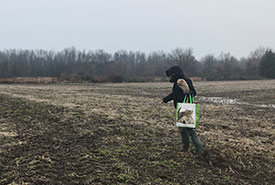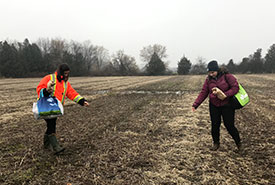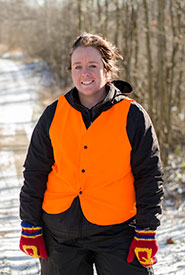Perfectly perfect perfection...not!

Seeding the field in one of the few not so “slurpy” spots. (Photo by NCC)
Imagine the perfect day in the field. A day where the sky is clear and blue. The sun is warm, but not too warm. A cool breeze wisps across your face, leaving you feeling refreshed and comfortable. The birds are singing, and the butterflies are fluttering. You sit down on an appropriately placed boulder under the perfect shade tree to eat your favourite field lunch. After lunch, you take a quick break to watch the clouds pass by above you, and you see a dog, then a dragon and then a snake. Ahhh, perfectly perfect perfection.
While the above scenario certainly does happen for field biologists, it is a rarity. Many field days are not as described above. In fact, most field days are not as described above.
Let’s take a project I worked on this past summer as an example. I was trying to restore an agricultural field into native grassland at the Nature Conservacny of Canada's Brighton Wetland property. This project involved having the farmer plant soybeans in the field in June; the soybeans keep the weeds down and deposit nitrogen into the soil. The farmer then harvested the soybeans in November, which meant we were ready to seed the area with native grassland plant species.
I could not have been more excited about a nice chilly autumn day in the field, with the sun warming my nose and the cool breeze keeping me comfortably content in a sweater. I imagined myself frolicking around the field, spreading seeds of native plants, while late migratory ducks flew overhead, and squirrels and voles scurried about trying to pick up the remnants of the soybean plants — a dream, really! And a dream really is what it was.
After some issues with the seed mix and volatile weather, by the end of November we were finally ready to go. Bags of seeds in tow, we were starting to walk out to the field when I heard a curious sound. Imagine, for a second, making enough banana bread batter to fill a small kids’ swimming pool. Then imagine putting on rubber boots and walking through that. “Slurrrrp…slurrrp…slurrrp.” Yes, that was the sound of our boots sinking into the deep, rich soil of the field (which was really just muck at this point).
I had just been out there two days earlier, but since then we had received a lot of rain, which took the frost out of the ground and created muck. The best part was that the ground was still frozen in some places, so sinking deeper into the muck than the top of your rain boots was a frequent but totally unpredictable occurrence. And let me tell you: it is NOT easy to get yourself out of that muck!

Tossing the seeds while a light drizzle of rain caused them to stick to our hands. (Photo by NCC)
As we started to toss the seeds about, slurping as we went, the rain began. Not a crazy downpour, but a light rain that was just heavy enough to get us sufficiently wet for the seeds to start sticking to our hands. To spread the seeds, we had to walk hunched over, blocking our hands from the rain. So, there we were — hunched over, wet, shivering, boots slurping away in the muck. A very different scenario than the magical day I had envisioned.
In the end, it took about three hours to seed one hectare (2.5 acres) of land. When we were done, we quickly retreated to our vehicle. We stopped for some warm tea on the way home, and we didn’t talk once about how crappy the weather was or how our backs hurt from hunching over, or how dirty our rain boots got our rental car. (OK – we did talk a bit about that last one!). Mostly we were focused on the project, forecasting what that field might look like in the spring, or two, or 10, years from now. How many grassland birds would soon call this habitat home? What new species would move into this community on their own?
Some days in the field are perfect, and we all cherish those days when they happen. Other days are not so perfect, and that is just fine. But we cherish those not-so-perfect days too. Those are the days that prompt us to remember our reason for doing our work and why we love our jobs.
This post originally appeared on Dispatches from the Field and is reposted with permission.


